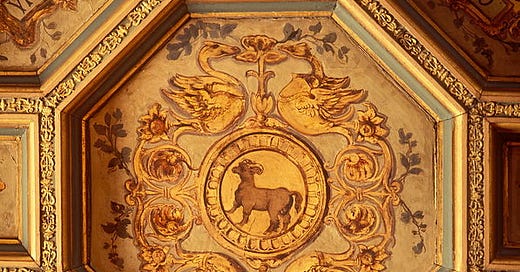The motto Anne Boleyn adopted when she became queen, “The Mooste Happy”, is the best known of all the mottoes she used but it wasn’t the only one she had. William Camden, the first biographer of Anne’s illustrious daughter Elizabeth I, wrote that Anne used the Latin Mihi et Mea, which translates as “For me and Mine”, as her motto. This motto can be spotted on the heraldic ceiling of the Chapel Royal in St James’s Palace dating to c. 1539-40. This forgotten motto of Anne’s can also be glimpsed in one of the colourful glass windows at Hampton Court Palace displaying the genealogy of Henry VIII, his six wives, and his chief minister Thomas Wolsey. It is not a contemporary addition, however; it was added during the restoration of Hampton Court in the 1840s by Edward Jesse.
“The Most Happy”
Since we are talking about Anne’s mottoes, let’s discuss them in detail. In the sixteenth century parlance “hap” meant “luck” so by “the most happy” Anne highlighted that she was “the luckiest” of women because she was raised to queenship. Deeply devout, Anne saw her social elevation as the act of God. On 24 June 1533, shortly after her coronation, Anne told the Venetian ambassador that “she knew that God had inspired His Majesty to marry her, and that he could have found a greater personage than herself.”
One of Anne’s favourite chaplains, William Latymer, recorded that she often emphasized that she became Queen because of “the loving kindness of Almighty God” to “whose only Providence she did continually attribute her royal estate.” No wonder, then, that in Latin, the language of the learned, Anne’s motto translates as “beatissima” or “felicitissima” and is a direct reference to the annunciation of the Virgin Mary. Anne’s “The Most Happy” motto appears on the medal struck in 1534; this medal is believed to have commemorated Anne’s second pregnancy. It would not be the first time when Anne linked herself with the Virgin; she exchanged love notes with Henry VIII on the pages of her prayer book, leaving this rhyming couplet under the image of Annunciation:
“By daily proof you shall me find.
To be to you both loving and kind.”
In December 1530, Anne had her servants’ liveries embroidered with “Ainsi sera groigne qui groigne”, “Let them grumble; that is how it is going to be”. The motto emphasised Anne’s feelings about her personal relationship with Henry VIII and her opinion about the policies recently adopted by the King. The motto was also a play on Margaret of Austria’s “Groigne qui groigne, vive Bourgogne!” which means “Grudge who grudges, long live Burgundy!” By the end of December 1530, however, Anne had removed the motto from her servants’ liveries. Imperial ambassador Eustace Chapuys took it as an indication that Anne was not aware of its imperialist origin, but the more likely explanation is that she deemed the motto too bold and perhaps disrespectful, considering the recent death of Margaret of Austria. Even if Anne’s motto lasted for only several weeks, it inspired a carol, perhaps written by poet Thomas Wyatt, who was enamoured with Anne. Since one of the stanzas pre-echoes Anne’s motto “The Most Happy” (“But makes me happiest that ever was”), it is possible that she herself was the author of the carol.





